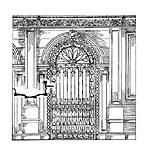
Two Monasteries Quite Contrary
MODERN BENEDICTINE & EASTERN ORTHODOX
Walking through a grand monastery such as St. Vincent Archabbey in Latrobe, Pennsylvania, at 8 A.M. on a snowy morning and seeing 20-some seminarians practicing saying Mass might make you pause, as it did me, to ponder the beauty of it all. Though the Chapel of St. Gregory where the seminarians were practicing has a modernist design, it has traditional elements and is not ugly in the way far too many desacralized modern churches seem to be. A large crucifix hangs suspended above the candle-adorned altar, and though there are no side altars — a statue of the Virgin Mary can be seen off to the side — the space retains a traditional feeling, unlike the grand altar in the monastery’s main basilica, which invokes the sterility of Bauhaus architecture.
The basilica’s high altar was removed in 1954, and then came the removal of numerous side altars at which priests said private Masses. Still, this vast empty space does have a kind of beauty: large, white marble statues of saints set against the side-aisle arches recall certain Roman period rooms in the Philadelphia Museum of Art. And yet, while attending Mass and daily prayers here, my eyes often drifted to the apse, where the former high altar used to be, now filled with small chairs and, in this season, a large, albeit beautiful Christmas tree. By contrast, the Basilica of SS Peter and Paul in Philadelphia kept its side altars and high altar, including the ornate baldacchino, intact after Vatican II. Monastery churches, however, tended to be subject to radical design innovations that pushed the envelope.
In 1846 a Benedictine monk named Boniface Wimmer arrived at St. Vincent with 18 monks. The group hailed from Bavaria, and their mission was to build churches and schools. After Wimmer was installed as pastor of St. Vincent in October of that year, he went on to establish the first Benedictine monastery, college, and seminary in North America. Ground was broken on St. Vincent de Paul (Minor) Basilica in 1891. It took 14 years to build.
St. Gregory’s chapel was designed by Fr. Vincent Crosby, a graduate of Philadelphia’s Tyler School of Art and a member of the Benedictine community since 1967. His international reputation as a designer of liturgical vestments for priests, bishops, popes, and even the archbishop of Canterbury, is well deserved. His studio, a few minutes’ walk from the main monastery, contains a vast collection of framed, icon-like images of saints, as well as vestments and copes that are simultaneously contemporary and traditional.
You May Also Enjoy
Reunion between the Catholic and Orthodox Churches should be the foremost focus of Catholic relations with other ecclesial bodies.
The apostolate of ecumenical clarification requires a willingness to see friends make themselves into enemies.
Russian Orthodox theologian Vladimir Soloviev considered himself both Russian Orthodox and Catholic, as both Churches are truly apostolic with valid sacraments.

